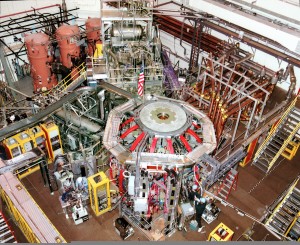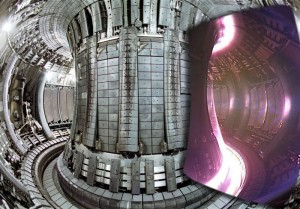Could it be that, in my lifetime, we will at least develop viable fusion power? I mean, the various space agencies are killing my hope that we’ll send someone to Mars in the next fifty years, but maybe we’re all desperate enough for energy that we can pull this colossal trick off, and catapult civilization to the next stage?
University of Tennessee researchers have successfully tested the technology that keeps the central solenoid of a tokamak fusion reactor stable. The actual solenoid for the ITER (International Thermonuclear Experimental Reactor) in France can now be built by General Atomics in San Diego. If successful, ITER will start running deuterium-tritium reactions in 2026. The expectation is that it will be able to output ten times more power than it inputs. Considering fusion reactors up till now have consumed more than they produce, this is a big leap.
Just to orient ourselves, this is a tokamak-type reactor from the outside:
And the internal torus surrounding the solenoid:
Unlike fission, nuclear fusion cannot result in an out-of-control chain reaction. We won’t have any Fukushima-like issue with this technology. While the neutron-bombarded walls of the reactor may be volatile, the production of hazardous waste from a fusion plant is much lower than that from a fission plant, or fossil fuel burning plants. A fusion plant could also potentially produce much more power than anything we have now.
The problem is the wear-and-tear on the chamber itself. Fusion reactions are hot – the optimal temperature for a deuterium-tritium reaction is 100,000,000 K. We’re talking about what happens in the core of the Sun, folks. It’s tough to keep it running continuously because the walls are getting slammed by high-energy particles. While the University of Tennessee researchers have helped to ensure the integrity of the central solenoid, that doesn’t solve all the problems involved.
In a way, green groups are right in saying that this is not the most cost-effective way to solve our energy and greenhouse gas issues. It isn’t. The ITER project alone will cost over $12 billion (probably way over). However, that doesn’t mean we should be sitting on our hands or relying on technologies that we already have. Yes, $12 billion can buy a lot of solar power, and I hope governments do that. At the same time, they should also be doing this. Just take it out of the defense budget on the justification that developing more efficient energy will save us from waging wars for resources in the future.
Well, folks, these are your tax dollars at work (well, actually it’s mostly European tax dollars at work). I’d rather they spend it on this than on stealth destroyers (which will cost around $7 billion a piece including development costs), but that’s just me.

